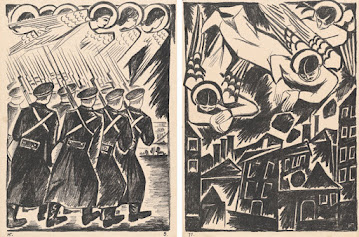Early Modern Era: The Influence of WWI
The First Modern World War lead to the gradual destruction of traditional style and subject matters in the early 1900s, as well as bringing an end to the impressionism era that thrived decades prior. During this 1910s, civilizations became more industrialized, and WWI was full modern weaponry and technology that allowed for battles and devastations to occur more efficiently. As a result, the war heavily influenced artists all over world, where each captured the terrible nightmare that reality has become and depicted their own experiences through their works. Here are some works I would like to present that depict the war, and another that present that emerged in the during it.
Christian Host from Mystical Images of War (Left) & Doomed City from Mystical Images of War (Right)
The Christian Host from Mystical Images of War and The Doom City from Mystical Images of War are 1914 prints by Russian artist Natalia Goncharova. Similar to many European individuals, Goncharova initially believed that the war would usher into a new era guided by peace, and as a result, her prints present illustrations that possess a spiritual dimension and are based on Biblical passages. The Christian Host illustrates a row of angels ushering and protecting a group of Russian troops into battle from above the clouds above. In the work, it is as if Goncharova almost was framing a battle between two nations to be similar to a religious mission, which would imply a fight between evil and good. Meanwhile, in the Doomed City, which also possess a biblical source, the illustration depicts boulders being hurled at a town by the angels. The title and the events of the Doom City evoke the destruction of Babylon, a destroyed city, even though the piece itself is simply comprised of buildings and factories. As the works above are prints, they illustrate the scenes monochromatically and are limited in color. We can see that Goncharova's linework appears rough in texture, as some areas are shaded more heavily with harsher darkness compared to others, and that her lines appear similar to pencil strokes, which are very scratchy looking. Furthermore, it is very noticeable how the artist's prints possess such strong straight lines, with only some features being either ellipses or slightly curved.
Stormtroopers advancing under a Gas Attack (Stormtruppe geht unter Gas vor)
Surrealism:
While the art of this era did reflect the chaos of the war, other art styles emerged during the hardships. Initially deriving from Dada, the art movement that heavily relied on chance, surrealism emerged as a new movement that also challenged tradition. Surrealism rejected the rational vision of life, allowing their mind to simply flow onto their artworks without any plans, and asserted the value of dreams and the unconscious. Although they appeared to be irrational, surrealist's illustrations would often subtly depict some sort of symbolism within a dream world scenario, or they possess hidden psychosocial tensions. Furthermore, surrealism was not limited to simply paintings, as there are also very famous sculptures and photographs.
The Jewish Angel
The Jewish Angel is a 1916 oil painting by Italian artist Giorgio de Chirico. A very prominent aspect of this painting is the oversized eye drawn on a piece of paper, and as De Chirico's father was an engineer, it has been thought that the eye and this scaffold-like structure might be an abstract portrait of him. And although it seems as if De Chirico just used objects related to construction and building, we can see how he utilized these shapes to form an outline of a person. Some notable objects are the scaffoldings, the piece of paper with an eye, different block shapes, and triangle making tools. Futhermore, as we know that surrealism broke traditional subject matter, this portrait of supposedly randomness can potentially be how De Chirico portrays his father in a dream-like way or can also be how he views him in his own mind.
Cited Works:
art-mus-thr200. Art 200x, 24 Apr. 2009, art200.community.uaf.edu/2009/04/24/03-visual-art-2/.
Nierendorfexpand_more, Otto Dix; Publisher: Karl. “Stormtruppe Geht Unter Gas Vor (Storm Troopers Advance under a Gas Attack), Plate 12 from Der Krieg (War), Otto Dix; Publisher: Karl Nierendorf ^ Minneapolis Institute of Art.” Mia, collections.artsmia.org/art/96545/stormtruppe-geht-unter-gas-vor-otto-dix.
Metmuseum.org, www.metmuseum.org/art/collection/search/489972.
Metmuseum.org, www.metmuseum.org/blogs/now-at-the-met/2018/world-war-i-female-artists.
Metmuseum.org, www.metmuseum.org/toah/hd/surr/hd_surr.htm.
Tate. “Surrealism – Art Term.” Tate, www.tate.org.uk/art/art-terms/s/surrealism.
“Stormtroopers Advance Under a Gas Attack.” Wikipedia, Wikimedia Foundation, 26 Mar. 2021, en.wikipedia.org/wiki/Stormtroopers_Advance_Under_a_Gas_Attack.
“Surrealism Movement Overview.” The Art Story, www.theartstory.org/movement/surrealism/.



Surrealism is not really one of my favorite styles, I don't understand it much. I really like the "Stormtroopers advancing under a gas attack" I see what you mean about it being hard to tell if they are smiling under the masks, the artist gives them a sort of evil-looking grimace as if they are enjoying themselves, very dark and interesting piece. the guy in the background looks extra creepy to me.
ReplyDeleteI honestly don't know how I feel about the "Mystical images of war". I grew up in a Catholic household but am not very religious myself, and these images are hard to look at. I understand how the artist believed that angels were looking after the soldier, and having an active-duty military husband myself I can't help but relate to it. But "the doomed city" it's hard to believe or imagine that angels would do that to a city full of people themselves, according to religion angels are meant to protect not harm.
Great choices overall.
Thank you for your blog, Luanne. I like the prints you decided to share about the war. I think it's interesting how both pieces reflect a very different attitude towards war. One reflects a divine intervention while the other reflects an animalistic and dehumanized appearance as you described. One thing I don't quite understand from your blog is how surrealism is a reflection of the chaos of war? It seems to me that surrealism is just another shift in art that opposes the previous era.
ReplyDelete